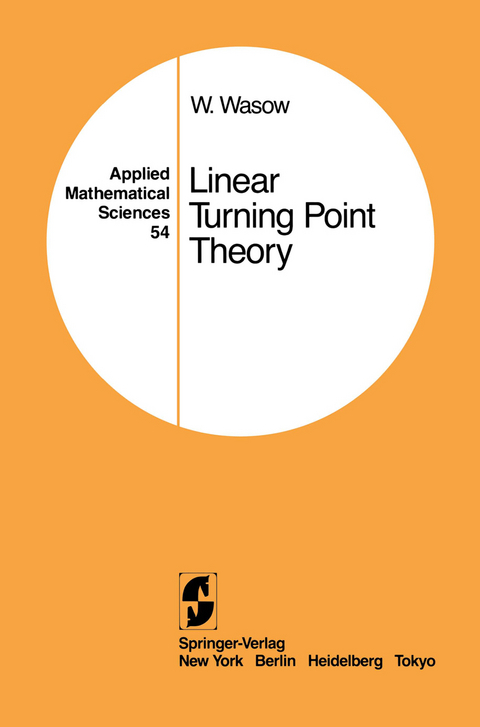
Linear Turning Point Theory
Springer-Verlag New York Inc.
978-0-387-96046-3 (ISBN)
I Historical Introduction.- 1.1. Early Asymptotic Theory Without Turning Points.- 1.2. Total Reflection and Turning Points.- 1.3. Hydrodynamic Stability and Turning Points.- 1.4. The So-Called WKB Method.- 1.5. The Contribution of R. E. Langer.- 1.6. Remarks on Recent Trends.- II Formal Solutions.- 2.1. Introduction.- 2.2. The Jordan Form of Holomorphic Functions.- 2.3. A Formal Block Diagonalization.- 2.4. Parameter Shearing: Its Nature and Purpose.- 2.5. Simplification by a Theorem of Arnold.- 2.6. Parameter Shearing: Its Application.- 2.7. Parameter Shearing: The Exceptional Case.- 2.8. Formal Solution of the Differential Equation.- 2.9. Some Comments and Warnings.- III Solutions Away From Turning Points.- 3.1. Asymptotic Power Series: Definition of Turning Points.- 3.2. A Method for Proving the Analytic Validity of Formal.- Solutions: Preliminaries.- 3.3. A General Theorem on the Analytic Validity of Formal.- Solutions.- 3.4. A Local Asymptotic Validity Theorem.- 3.5. Remarks on Points That Are Not Asymptotically Simple.- IV Asymptotic Transformations of Differential Equations.- 4.1. Asymptotic Equivalence.- 4.2. Formal Invariants.- 4.3. Formal Circuit Relations with Respect to the Parameter.- V Uniform Transformations at Turning Points: Formal Theory.- 5.1. Preparatory Simplifications.- 5.2. A Method for Formal Simplification in Neighborhoods of a Turning Point.- 5.3. The Case h > 1.- 5.4. The General Theory for n = 2.- VI Uniform Transformations at Turning Points: Analytic Theory.- 6.1. Preliminary General Results.- 6.2. Differential Equations Reducible to Airy’s Equation.- 6.3. Differential Equations Reducible to Weber’s Equation.- 6.4. Uniform Transformations in a Full Neighborhood of.- a Turning Point.- 6.5. Complete Reduction to Airy’s Equation.- 6.6.Reduction to Weber’s Equation in Wider Sectors.- 6.7. Reduction to Weber’s Equation in a Full Disk.- VII Extensions of the Regions of Validity of the Asymptotic Solutions.- 7.1. Introduction.- 7.2. Regions of Asymptotic Validity Bounded by Separation Curves: The Problem.- 7.3. Solutions Asymptotically Known in Sectors Bounded by.- Separation Curves.- 7.4. Singularities of Formal Solutions at a Turning Point.- 7.5. Asymptotic Expansions in Growing Domains.- 7.6. Asymptotic Solutions in Expanding Regions: A General Theorem.- 7.7. Asymptotic Solutions in Expanding Regions: A Local Theorem.- VIII Connection Problems.- 8.1. Introduction.- 8.2. Stretching and Parameter Shearing.- 8.3. Calculation of the Restraint Index.- 8.4. Inner and Outer Solutions for a Particular nth-Order System.- 8.5. Calculation of a Central Connection Matrix.- 8.6. Connection Formulas Calculated Through Uniform Simplification.- IX Fedoryuk’s Global Theory of Second-Order Equations.- 9.1. Global Formal Solutions of ?2u”=a(x)u2u“ = a(x)u.- 9.2. Separation Curves for ?2u”=a(x)u2u“ = a(x)u.- 9.3. A Global Asymptotic Existence Theorem for ?2u”=a(x)u2u“ = a(x)u.- X Doubly Asymptotic Expansions.- 10.1. Introduction.- 10.2. Formal Solutions for Large Values of the.- Independent Variable.- 10.3. Asymptotic Solutions for Large Values of the.- Independent Variable.- 10.4. Some Properties of Doubly Asymptotic Solutions.- 10.5. Central Connection Problems in Unbounded Regions.- XI A Singularly Perturbed Turning Point Problem.- 11.1. The Problem.- 11.2. A Simple Example.- 11.3. The General Case: Formal Part.- 11.4. The General Case: Analytic Part.- XII Appendix: Some Linear Algebra for Holomorphic Matrices.- 12.1. Vectors and Matrices of Holomorphic Functions.- 12.2. Reduction to JordanForm.- 12.3. General Holomorphic Block Diagonalization.- 12.4. Holomorphic Transformation of Matrices into Arnold’s Form.- References.
| Erscheint lt. Verlag | 7.1.1985 |
|---|---|
| Reihe/Serie | Applied Mathematical Sciences ; 54 |
| Zusatzinfo | IX, 246 p. |
| Verlagsort | New York, NY |
| Sprache | englisch |
| Maße | 155 x 235 mm |
| Themenwelt | Mathematik / Informatik ► Mathematik ► Analysis |
| Mathematik / Informatik ► Mathematik ► Wahrscheinlichkeit / Kombinatorik | |
| ISBN-10 | 0-387-96046-5 / 0387960465 |
| ISBN-13 | 978-0-387-96046-3 / 9780387960463 |
| Zustand | Neuware |
| Haben Sie eine Frage zum Produkt? |
aus dem Bereich


